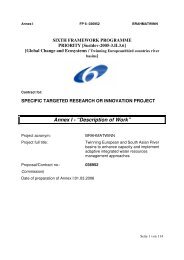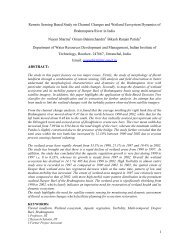WP 5 Analysis of present IWRM practices - Brahmatwinn
WP 5 Analysis of present IWRM practices - Brahmatwinn
WP 5 Analysis of present IWRM practices - Brahmatwinn
Create successful ePaper yourself
Turn your PDF publications into a flip-book with our unique Google optimized e-Paper software.
3 Major water users in the UBRB<br />
In this chapter the water supply situation for the sectors public water supply and industrial water<br />
uses in the different states along the Brahmaputra River will be <strong>present</strong>ed. It becomes clear that<br />
water consumption <strong>of</strong> the industrial sector is comparatively low in Tibet and Bhutan. Most <strong>of</strong> the<br />
available fresh water is used by the agricultural sector.<br />
3.1 General situation in the UBRB<br />
The water consumption situation is totally different in the riparian states <strong>of</strong> the Brahmaputra. While<br />
Tibet is characterized by a sparse population and respectively low water demands, Bhutan shows<br />
high potential <strong>of</strong> hydropower production and high potential <strong>of</strong> irrigation. Assam has the largest<br />
population and highest population density. Water demand is high for public water supply and<br />
irrigation water.<br />
The Brahmaputra River flows through some <strong>of</strong> the most densely populated areas in the world. The<br />
countries downstream <strong>of</strong> the Brahmaputra, India and Bangladesh depend mostly on the water <strong>of</strong> the<br />
Brahmaputra River. Because <strong>of</strong> large population, water demand is high and population increases<br />
continuously. These countries depend on the water resources in adequate quantity and quality<br />
coming from upstream countries Tibet and Bhutan. Due to this situation conflicts in respective to<br />
competitive water demands between countries arise.<br />
Fig. 5: Population density in the Brahmaputra river basin<br />
(ICIMOD 2005).<br />
The average population density in the basin is estimated to be 182 persons/ km 2 (IUCN, IWMI,<br />
RAMSAR CONVENTION BUREAU 2002) which results in a total population <strong>of</strong> 118 Million people for the<br />
entire basin (ICIMOD 2005). However, the population density varies widely between the sparsely<br />
12





